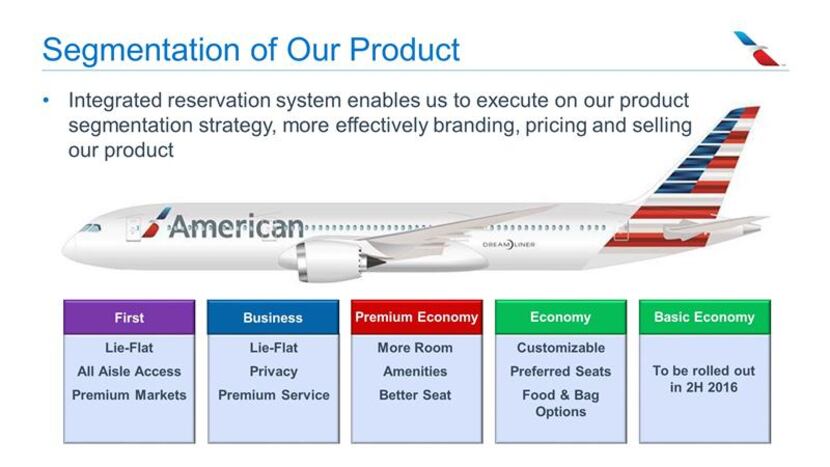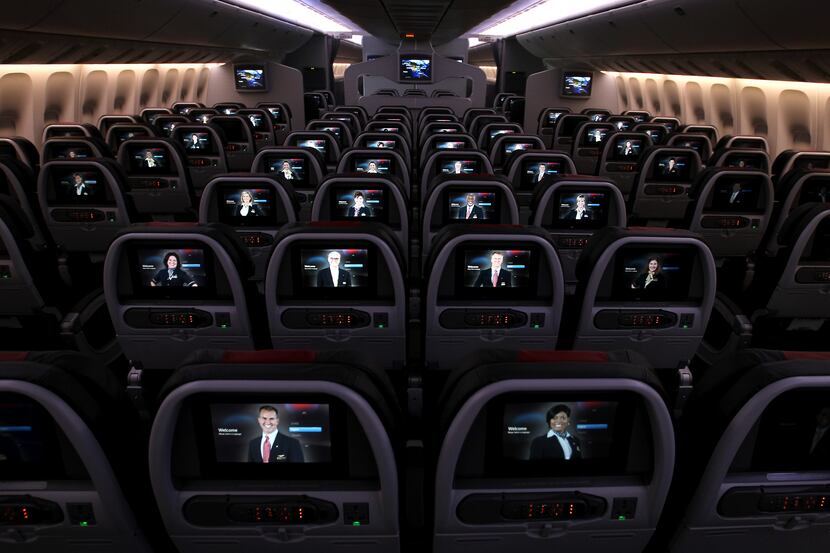Passengers flying American Airlines and other major U.S. carriers later this year should get familiar with a new industry buzzword that could mean the difference between extra legroom and sitting in the middle seat at the back of the plane.
The term — segmentation — is airline speak for dividing up the cabin into different price groups, with varying levels of service for each. While everyone’s familiar with the most traditional divisions — first, business and economy classes — airlines are looking for new ways to bring in revenue by subdividing the economy class even further.
On Wednesday, the Fort-Worth based company’s new president Robert Isom gave one of the most comprehensive overviews to date of what segmentation will look like when it arrives.
Here’s how he described it:
First class: A "super premium product" with lie-flat seats and all-aisle access configuration for "customers" who are willing to pay for that service. First-class cabins will mostly be limited to "premium markets" like international and transcontinental routes.
Business class: A product that "will also have flat seats, some privacy as well in terms of the seating configuration and premium service as well offered for that."
“When you take a look at business class product in the premium economy, those would be different seats,” Isom said during a presentation to investors in Boston Wednesday.

Premium economy: An offering that is "better than economy." "More room, better seat, better services, more amenities," is how Isom described it.
Economy: The typical coach fare, with an emphasis on being "customizable by the customer." The fare will include preferred seat assignments, with add-on options for food and baggage.
Basic economy: A new fare type that will offer the lowest prices for the most basic offering — a seat on a plane, with few if any extras.
“For instance, on basic economy, we haven’t announced all the attributes to go with that, but it wouldn’t come with a seat assignment,” Isom said. Other things you might have to pay extra for include priority boarding options and bags.
Already, American has announced plans to introduce a premium economy option — with bigger seats, more legroom and better meals — on two international routes out of DFW starting this November. Plans for a bare-bones basic economy fare are in the works, and American said they'll be in place by the end of this year, although few other details have been released.
Delta Air Lines has already introduced a basic economy offering on some of its flights, while United Airlines has indicated it will do the same later this year, a move that’s even more likely with the arrival of American’s former president Scott Kirby, who had championed the company’s segmentation strategy.
So why the rush to segment? For customers, it might seem like the latest instance of having to pay more for what used to be included with the price of a ticket. But American sees it as a way to better match the level of service with what customers pay for.
This is especially important as Americans and others compete with ultra-low cost carriers like Spirit Airlines, which offer base fares that often undercut those of the legacy carriers and charge extra for everything from bags to snacks.
American has been aggressive in matching Spirit’s fares in several of its markets, including Dallas, and basic economy is a way to appeal to customers who care about the price of their ticket above all else.
“We do think that there is way to ensure that we’re offering our customers what they want, but also doing it in a way that allows us to ensure people are paying for what they get as well,” Isom said of segmentation. “I think it will allow us, no matter the environment to be able to compete.”
The segmentation push will likely please investors, who have fretted about declining revenue trends in the airline industry. Earlier this year, Kirby said he'd be "disappointed" if adding basic and premium economy options didn't add up to over a billion dollars in positive economic impact for American.
Related stories
American Airlines introduces premium economy class with bigger seats on DFW routes
Pass the popcorn: American Airlines makes in-flight movies and TV free for all
American Airlines strikes deals to bring high-speed Wi-Fi to more of its planes

